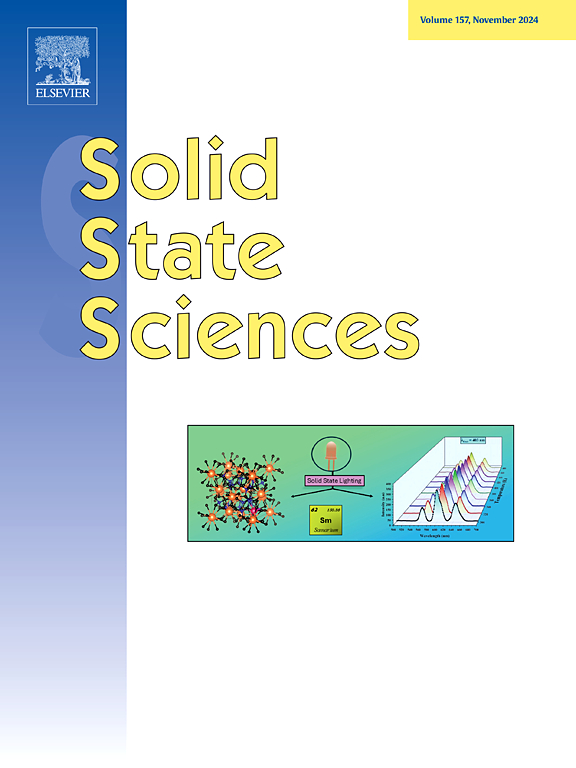Study of substrate dependent microstructural properties of sputtered Mo/CZTS heterojunctions using X ray diffraction
IF 3.3
3区 化学
Q2 CHEMISTRY, INORGANIC & NUCLEAR
引用次数: 0
Abstract
Thin films of CZTS (Cu2ZnSnS4) were deposited using radiofrequency sputtering (RF) at varying sputtering powers on soda lime glass coated with molybdenum (Mo). Direct current (DC) sputtering was used to deposit Mo thin films at various sputtering powers. Rapid thermal processing (RTP) was employed to anneal the thin films that had been deposited at temperatures of 300, 400, and 500 °C. X ray diffraction (XRD) technique was used to probe thin films structurally. The microstructural characteristics, such as crystallite size and microstrain, were calculated. These properties, particularly crystallite size and microstrain, are critical in future applications as an absorber layer in a thin film solar cell. A comprehensive comparative study has been carried out using Scherrer method, Williamson-Hall method, Halder-Wagner method, Size-Strain plot method, and Wagner-Aqua method. Crystallite size and microstrain obtained in this work shows strong dependence on preferential orientation of DC sputtered Mo base layer. Crystallite size, microstrain measured shows similar trends. Microstrain obtained exhibits systematic relationship with variation in deposition parameters of DC sputtered Mo thin films and RF sputtered CZTS thin films. This dependency of CZTS microstructural features on base layer Mo growth conditions can be used in the future to apply CZTS as a solar cell absorber layer.

利用 X 射线衍射研究溅射钼/CZTS 异质结的基底相关微结构特性
在涂有钼(Mo)的钠钙玻璃上使用射频溅射(RF)技术以不同的溅射功率沉积了 CZTS(Cu2ZnSnS4)薄膜。在不同的溅射功率下,采用直流溅射沉积钼薄膜。在 300、400 和 500 °C 的温度下,采用快速热处理 (RTP) 对沉积的薄膜进行退火。X 射线衍射 (XRD) 技术用于从结构上探测薄膜。计算了结晶尺寸和微应变等微观结构特征。这些特性,尤其是晶粒尺寸和微应变,对于未来作为薄膜太阳能电池吸收层的应用至关重要。我们使用舍勒法、威廉森-霍尔法、哈尔德-瓦格纳法、尺寸-应变图法和瓦格纳-水法进行了全面的比较研究。这项研究获得的晶体尺寸和微应变与直流溅射钼基底层的优先取向有很大关系。所测得的晶体尺寸和微应变显示出相似的趋势。获得的微应变与直流溅射钼薄膜和射频溅射 CZTS 薄膜沉积参数的变化呈现出系统关系。CZTS 的微观结构特征与基底层钼生长条件的这种依赖关系可用于将来将 CZTS 用作太阳能电池吸收层。
本文章由计算机程序翻译,如有差异,请以英文原文为准。
求助全文
约1分钟内获得全文
求助全文
来源期刊

Solid State Sciences
化学-无机化学与核化学
CiteScore
6.60
自引率
2.90%
发文量
214
审稿时长
27 days
期刊介绍:
Solid State Sciences is the journal for researchers from the broad solid state chemistry and physics community. It publishes key articles on all aspects of solid state synthesis, structure-property relationships, theory and functionalities, in relation with experiments.
Key topics for stand-alone papers and special issues:
-Novel ways of synthesis, inorganic functional materials, including porous and glassy materials, hybrid organic-inorganic compounds and nanomaterials
-Physical properties, emphasizing but not limited to the electrical, magnetical and optical features
-Materials related to information technology and energy and environmental sciences.
The journal publishes feature articles from experts in the field upon invitation.
Solid State Sciences - your gateway to energy-related materials.
 求助内容:
求助内容: 应助结果提醒方式:
应助结果提醒方式:


